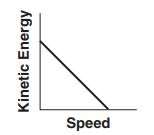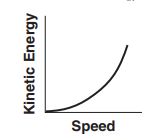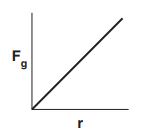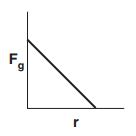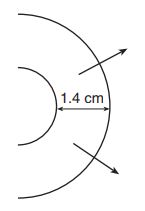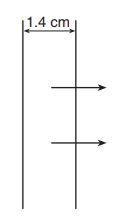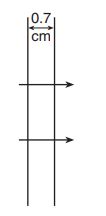1. Which term identifies a scalar quantity?
(1) displacement
(2) momentum
(3) velocity
(4) time
2. Two -newton forces act concurrently on an object. What angle between these forces will produce a resultant force with the greatest magnitude?
(1)
(2)
(3)
(4)
3. A car traveling west in a straight line on a highway decreases its speed from meters per second to
meters per second in
seconds. The car’s average acceleration during this time interval is
(1)
east
(2)
west
(3)
east
(4)
west
4. In a race, a runner traveled meters in
seconds as she accelerated uniformly from rest. The magnitude of the acceleration of the runner was
(1)
(2)
(3)
(4)
5. A projectile is launched at an angle above the ground. The horizontal component of the projectile’s velocity, , is initially
meters per second. The vertical component of the projectile’s velocity,
, is initially
meters per second. What are the components of the projectile’s velocity after
seconds of flight? [Neglect friction.]
(1) m/s and
m/s
(2) m/s and
m/s
(3) and
m/s
(4) m/s and
m/s
6. A ball is thrown with an initial speed of meters per second. At what angle above the horizontal should the ball be thrown to reach the greatest height?
(1)
(2)
(3)
(4)
7. Which object has the greatest inertia?
(1) a -kg bullet traveling at
m/s
(2) a -kg child traveling at
m/s on her bike
(3) a -kg elephant walking with a speed of
m/s
(4) a -kg car at rest in a parking lot
8. An -newton wooden block slides across a horizontal wooden floor at constant velocity. What is the magnitude of the force of kinetic friction between the block and the floor?
(1) N
(2) N
(3) N
(4) N
9. Which situation represents a person in equilibrium?
(1) a child gaining speed while sliding down a slide
(2) a woman accelerating upward in an elevator
(3) a man standing still on a bathroom scale
(4) a teenager driving around a corner in his car
10. A rock is thrown straight up into the air. At the highest point of the rock’s path, the magnitude of the net force acting on the rock is
(1) less than the magnitude of the rock’s weight, but greater than zero
(2) greater than the magnitude of the rock’s weight
(3) the same as the magnitude of the rock’s weight
(4) zero
11. The diagram below shows a compressed spring between two carts initially at rest on a horizontal, frictionless surface. Cart has a mass of
kilograms and cart
has a mass of
kilogram. A string holds the carts together.
The string is cut and the carts move apart. Compared to the magnitude of the force the spring exerts on cart , the magnitude of the force the spring exerts on cart
is
(1) the same
(2) half as great
(3) twice as great
(4) four times as great
12. An -newton block is accelerating down a frictionless ramp inclined at
to the horizontal, as shown in the diagram below.
What is the magnitude of the net force causing the block’s acceleration?
(1) N
(2) N
(3) N
(4) N
13. At a certain location, a gravitational force with a magnitude of newtons acts on a
-kilogram astronaut. What is the magnitude of the gravitational field strength at this location?
(1) kg/N
(2) N/kg
(3) m/s2
(4) N
kg
14. A spring gains joules of elastic potential energy as it is compressed
meter from its equilibrium position. What is the spring constant of this spring?
(1) N/m
(2) N/m
(3) N/m
(4) N/m
15. When a teacher shines light on a photocell attached to a fan, the blades of the fan turn. The brighter the light shone on the photocell, the faster the blades turn. Which energy conversion is illustrated by this demonstration?
(1) light thermal
mechanical
(2) light nuclear
thermal
(3) light electrical
mechanical
(4) light mechanical
chemical
16. Which statement describes a characteristic common to all electromagnetic waves and mechanical waves?
(1) Both types of waves travel at the same speed.
(2) Both types of waves require a material medium for propagation.
(3) Both types of waves propagate in a vacuum.
(4) Both types of waves transfer energy.
17. An electromagnetic wave is produced by charged particles vibrating at a rate of vibrations per second. The electromagnetic wave is classified as
(1) a radio wave
(2) an infrared wave
(3) an x-ray
(4) visible light
18. The energy of a sound wave is most closely related to the wave’s
(1) frequency
(2) amplitude
(3) wavelength
(4) speed
19. A sound wave traveling eastward through the air causes the air molecules to
(1) vibrate east and west
(2) vibrate north and south
(3) move eastward, only
(4) move northward, only
20. What is the speed of light ( Hz) in ethyl alcohol?
(1) m/s
(2) m/s
(3) m/s
(4)
21. In the diagram below, an ideal pendulum released from position swings freely to position
.
As the pendulum swings from to
, its total mechanical energy
(1) decreases, then increases
(2) increases, only
(3) increases, then decreases
(4) remains the same
22. The diagram below represents a periodic wave.
Which two points on the wave are out of phase?
(1) and
(2) and
(3) and
(4) and
23. A dry plastic rod is rubbed with a wool cloth and then held near a thin stream of water from a faucet. The path of the stream of water is changed, as represented in the diagram below.
Which force causes the path of the stream of water to change due to the plastic rod?
(1) nuclear
(2) magnetic
(3) electrostatic
(4) gravitational
24. A distance of meter separates successive crests of a periodic wave produced in a shallow tank of water. If a crest passes a point in the tank every
second, what is the speed of this wave?
(1) m/s
(2) m/s
(3) m/s
(4) m/s
25. One vibrating -hertz tuning fork transfers energy to another
-hertz tuning fork, causing the second tuning fork to vibrate. This phenomenon is an example of
(1) diffraction
(2) reflection
(3) refraction
(4) resonance
26. Sound waves are produced by the horn of a truck that is approaching a stationary observer. Compared to the sound waves detected by the driver of the truck, the sound waves detected by the observer have a greater
(1) wavelength
(2) frequency
(3) period
(4) speed
27. An electronvolt is a unit of
(1) energy
(2) charge
(3) electric field strength
(4) electric potential difference
28. Which particle would produce a magnetic field?
(1) a neutral particle moving in a straight line
(2) a neutral particle moving in a circle
(3) a stationary charged particle
(4) a moving charged particle
29. A physics student takes her pulse and determines that her heart beats periodically times in
seconds. The period of her heartbeat is
(1) Hz
(2) Hz
(3) s
(4) s
30. Moving coulombs of charge through a circuit requires
joules of electric energy. What is the potential difference across this circuit?
(1) V
(2) V
(3) V
(4) V
31. The diagram below shows currents in a segment of an electric circuit.
What is the reading of ammeter ?
(1) A
(2) A
(3) A
(4) A
32. An electric dryer consumes joules of electrical energy when operating at
volts for
seconds. During operation, the dryer draws a current of
(1) A
(2) A
(3) A
(4) A
33. Which net charge could be found on an object?
(1) C
(2) C
(3) C
(4) C
34. A photon is emitted as the electron in a hydrogen atom drops from the energy level directly to the
energy level. What is the energy of the emitted photon?
(1) eV
(2) eV
(3) eV
(4) eV
35. In a process called pair production, an energetic gamma ray is converted into an electron and a positron. It is not possible for a gamma ray to be converted into two electrons because
(1) charge must be conserved
(2) momentum must be conserved
(3) mass-energy must be conserved
(4) baryon number must be conserved
36. The approximate length of an unsharpened No. pencil is
(1) m
(2) m
(3) m
(4) m
37. The diagram below shows an -kilogram cart moving to the right at
meters per second about to make a head-on collision with a
-kilogram cart moving to the left at
meters per second.
After the collision, the -kilogram cart moves to the right at
meters per second. What is the velocity of the
-kilogram cart after the collision?
(1) m/s left
(2) m/s right
(3) m/s left
(4) m/s right
38. Four forces act concurrently on a block on a horizontal surface as shown in the diagram below.
As a result of these forces, the block
(1) moves at a constant speed to the right
(2) moves at a constant speed to the left
(3) accelerates to the right
(4) accelerates to the left
39. If a motor lifts a -kilogram mass a vertical distance of
meters in
seconds, the minimum power generated by the motor is
(1) W
(2) W
(3) W
(4) W
40. A -kilogram object is accelerated at
meters per second2 north by an unbalanced force. The same unbalanced force acting on a
-kilogram object will accelerate this object toward the north at
(1)
(2)
(3)
(4)
41. An electron is located in an electric field of magnitude newtons per coulomb. What is the magnitude of the electrostatic force acting on the electron?
(1) N
(2) N
(3) N
(4) N
42. The current in a wire is amperes. The time required for
electrons to pass a certain point in the wire is
(1) s
(2) s
(3) s
(4) s
43. When two point charges of magnitude and
are separated by a distance,
, the magnitude of the electrostatic force between them is
. What would be the magnitude of the electrostatic force between point charges
and
when separated by a distance of
?
(1)
(2)
(3)
(4)
44. The composition of a meson with a charge of elementary charge could be
(1)
(2)
(3)
(4)
45. Which graph represents the relationship between the kinetic energy and the speed of a freely falling object?
(1)
(2)
(3)
(4)
46. Which diagram represents the electric field between two oppositely charged conducting spheres?
(1)
(2)
(3)
(4)
47. Which graph represents the relationship between the magnitude of the gravitational force, , between two masses and the distance,
, between the centers of the masses?
(1)
(2)
(3)
(4)
48. The diagram below shows two waves traveling toward each other at equal speed in a uniform medium.
When both waves are in the region between points and
, they will undergo
(1) diffraction
(2) the Doppler effect
(3) destructive interference
(4) constructive interference
49. The diagram below shows a series of straight wavefronts produced in a shallow tank of water approaching a small opening in a barrier.
Which diagram represents the appearance of the wavefronts after passing through the opening in the barrier?
(1)
(2)
(3)
(4)
50. The graph below represents the relationship between energy and the equivalent mass from which it can be converted.
The slope of this graph represents
(1)
(2)
(3)
(4)










